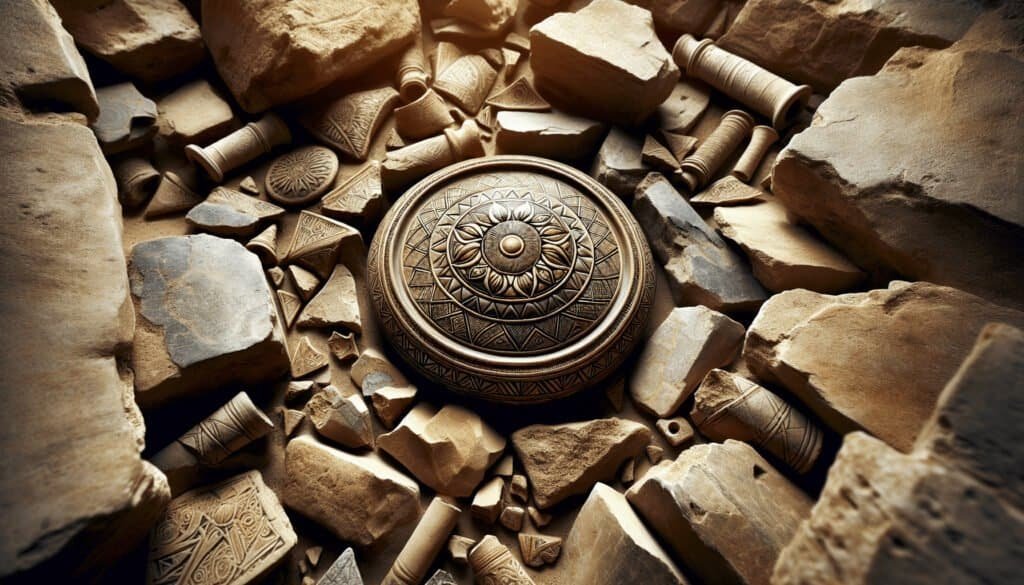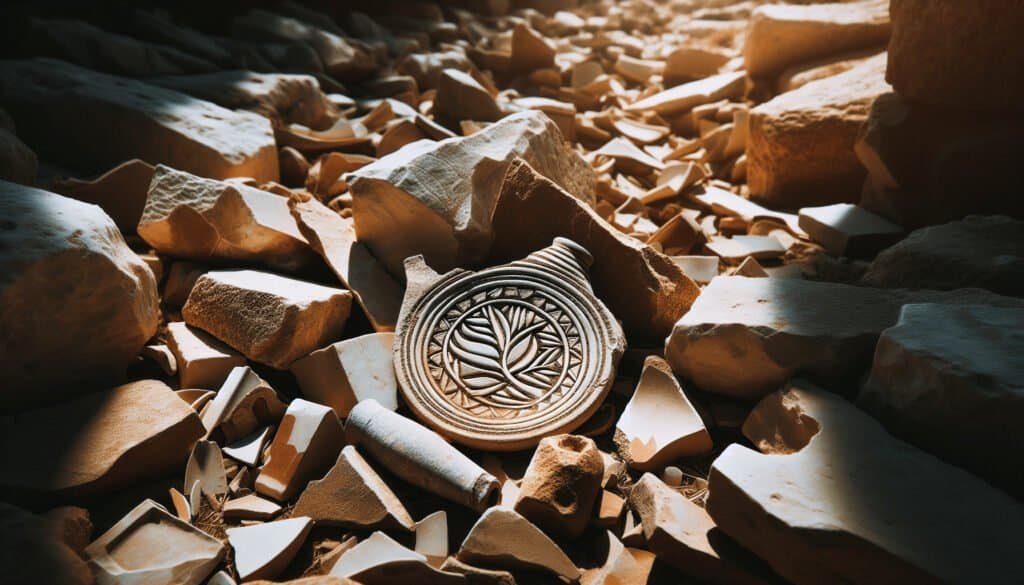What if I told you that the remnants of a once-thriving community are whispering secrets about ancient rituals, sacred texts, and temple artifacts? You might be surprised to learn that such a place exists, known as the Qumran Workshop Ruins. This site, nestled near the shores of the Dead Sea, holds the key to unlocking chapters of history that many may have thought lost to time.

A Glimpse into the Past: The Qumran Community
The Qumran site is not merely an assemblage of crumbling walls and dusty artifacts; it was once home to a devout sect, believed to be the Essenes. This ascetic Jewish group flourished from the second century BCE until the first century CE. They were known for their rigorous adherence to religious laws and communal living. Interestingly, their commitment to spiritual practices leads us to consider how they might have contributed to the religious texts we study today.
Who Were the Essenes?
You may be wondering what sets the Essenes apart from other Jewish groups of their time. They were distinct in their lifestyle and beliefs. Unlike the Pharisees, who interpreted the Law rigorously, or the Sadducees, who held considerable power in the Temple, the Essenes chose a more secluded existence. They believed in purifying themselves through ritual baths, shared communal meals, and adhering closely to a set of rules governing their daily activities. Their separation from mainstream Judaism was, in many ways, a spiritual rebellion against the Temple practices they deemed corrupt.
The Significance of the Dead Sea Scrolls
A central aspect of Qumran’s historical significance is its connection to the Dead Sea Scrolls. These ancient texts, discovered in the nearby caves in the late 1940s, include biblical manuscripts, sectarian writings, and various other documents. The majority of these scrolls date from the third century BCE to the first century CE, offering scholars invaluable insights into the religious landscape of the time.
The scrolls are crucial for understanding the diversity of Jewish thought and practice during the Second Temple period. Not only do they include fragments of biblical texts, but they also contain the community’s interpretations of scripture, shedding light on how they viewed their relationship with God.
The Qumran Workshop and Temple Artifacts
One of the most intriguing aspects of Qumran is its workshop, which hints at the community’s socio-economic activities. While you might picture monks scribbling scrolls, the community was skilled in various crafts and trades, including pottery, textile production, and metalworking.
Pottery: A Window into Daily Life
At the heart of Qumran’s activities was pottery, which serves both practical and ceremonial purposes. Archaeologists have uncovered numerous pottery fragments in the Qumran area, reflecting the community’s daily needs and ritual practices.
- Types of Pottery:
- Cooking Pots: Utilitarian ware used for food preparation.
- Storage Jars: For grain and water, often large and robust.
- Ritual Vessels: Decorated pottery used in religious ceremonies, showcasing the community’s artistic flair.
These pottery pieces offer insights not only into the daily lives of the Essenes but also into their values and practices, including their obsessive attention to purity laws.
Metalwork: The Art of Sacred Craftsmanship
In addition to pottery, the metalworking found at Qumran adds another dimension to understanding this community’s expertise. Artifacts like small weights and ritual objects provide clues to how they may have interacted with the Temple authorities. The production of temple-related items indicates that the Qumran community did not simply isolate itself from the broader spiritual landscape but rather engaged with it in significant ways.
Types of Metal Artifacts
| Artifact Type | Function | Significance |
|---|---|---|
| Weights | Used for measuring | Indicates trade practices with the Temple |
| Ritual Implements | Used in ceremonies | Reflects religious beliefs and practices |
| Tools | Everyday instruments | Shows technological knowledge and utility |
Through these artifacts, it becomes clear that the Essenes were not just passive observers of religious life; they actively contributed to it, crafting items that may have been used in Temple rituals despite their physical separation from the Temple in Jerusalem.

The Role of Rituals at Qumran
At the heart of the Qumran community’s identity were its rituals, which held both social and spiritual significance. The practices they engaged in were not random; they were deeply meaningful actions that formed the basis of their belief system.
Daily Life and Ritual Practices
The Essenes adhered to a strict daily schedule that included prayer, communal meals, and study of the scriptures. These routines were not just about structure; they reinforced their sense of unity and mission.
Key Rituals
- Purity Laws: The community emphasized ritual purity, requiring members to perform frequent washings.
- Sabbath Observance: They observed the Sabbath with particular solemnity, seeing it as a time to sanctify their community.
Through these practices, you can see how the community strove to maintain a closer connection to God, viewing their lives as an ongoing act of devotion.
Community Meals as Rituals of Unity
One of the most distinctive features of the Qumran community was the communal meal, which served as both nourishment and a reaffirmation of their shared values. These meals were conducted in a highly ritualized manner, reflecting their dedication to inclusivity and reverence.
- Structure of the Meal:
- Invitation to Participate: Members would gather and reaffirm their commitment to communal living.
- Blessing over the Food: A ritual blessing might be offered, emphasizing gratitude and unity.
- Breaking Bread: The act of sharing food symbolized their bond and commitment to each other.
Such practices highlight how the Essenes viewed their community not merely as a collection of individuals but as a spiritual family aligned in faith and purpose.
Archaeological Findings: A Testament to Faith
Archaeology plays a crucial role in our understanding of the Qumran community and its practices. Excavations in the area have uncovered a wealth of artifacts that paint a picture of ancient life.
The Significance of the Ruins
The ruins of the Qumran settlement are a wealth of archaeological information. They suggest that this was more than just a place of retreat; it was a highly organized community. You might be surprised to learn that the site includes various structures that hint at complex social relations and economic activities.
Key Structures Found at Qumran
| Structure Type | Purpose | Findings |
|---|---|---|
| Water System | Ritual purification | Aqueducts and cisterns for water supply |
| Communal Dining Room | Community meals and gatherings | Large, well-constructed dining area |
| Study Rooms | Scriptorium for text reproduction | Tables and ink pots found |
| Ritual Baths | Bathing for purity | Multiple immersion pools discovered |
The meticulous planning and construction of these facilities underscore the community’s commitment to its ideals and practices, making it a focal point for understanding the religious and cultural dynamics of the time.
The Quest for Temple Artifacts
As we navigate through Qumran’s rich archaeological landscape, your curiosity might lead you to wonder about the significance of temple artifacts. These treasures provide tantalizing clues about the community’s interactions with the Temple in Jerusalem, their beliefs, and the cultural milieu of Second Temple Judaism.
What Constitutes Temple Artifacts?
You may question what specifically is considered a temple artifact. Generally, these items are associated with religious practices and rituals conducted within the Temple. They range from daily use items to sacred vessels designed for specific ceremonial purposes.
Categories of Temple Artifacts
- Vessels: Used in rituals, such as bowls and plates.
- Weights and Measures: Indicative of trade and offerings at the Temple.
- Textual References: Manuscripts that shed light on the community’s understanding of Temple worship.
The presence of such artifacts at Qumran suggests a deeper connection to the Temple, despite the community’s physical distance from it.
Significance of Restoring Temple Artifacts
You might ponder why the restoration of artifacts found at Qumran is critical for understanding the broader historical narrative. Restoring these pieces allows archaeologists and historians to piece together aspects of daily life, worship, and the spiritual context of ancient Judaism.
- Historical Context: Each artifact serves as a testament to the community’s beliefs and practices, revealing how they viewed themselves in relation to the Temple.
- Cultural Exchange: The artifacts underscore interactions between different Jewish sects and highlight the diversity within Second Temple Judaism.
Restoring these temple artifacts also allows modern scholars to illustrate the seamless blend of religious, social, and economic life that characterized this ancient community.
The Influence of Qumran on Modern Perspectives
The findings at Qumran not only enrich our understanding of the past but also have profound implications for the modern world. The quest for knowledge about the Essenes and their practices invites you to consider how ancient beliefs continue to resonate today.
Lessons from the Essenes
You might find it fascinating that the Essenes have much to teach contemporary society about community, spirituality, and commitment to ideals. Their emphasis on purity, communal living, and the sacredness of text offers insights for those navigating the complexities of modern life.
- Community Living: In an age of individualism, the Essenes remind us of the value of community and shared purpose.
- Spiritual Practices: Their dedication to ritual and purity continues to inspire those seeking spiritual depth in an increasingly secular world.
The practices of the Qumran sect may seem distant in time, but their commitment to a communal and spiritual life resonates in modern discussions surrounding faith, practice, and community.
Contemporary Scholarship and Spirituality
Today, scholars and spiritual seekers continue to explore Qumran’s teachings and artifacts. You may find this exploration essential, as it not only enriches academic discussions but also invigorates spiritual practices among various denominations.
- Biblical Studies: The Dead Sea Scrolls have revitalized interest in textual criticism and historical contexts of scripture.
- Interfaith Dialogues: Qumran serves as a bridge in understanding Jewish-Christian relations, demonstrating shared heritage and beliefs.
As our understanding of Qumran deepens, it encourages a broader conversation about faith, tradition, and community across diverse religious landscapes.
Summary: Tying the Ancient to the Present
As you reflect on the ruins of Qumran and their significance, it’s clear that they represent much more than mere stones and artifacts. They hold the keys to understanding a community deeply committed to spiritual purity, communal living, and active participation in the religious life of their time. The artifacts unearthed there are not temporal remnants but rather echoes of a vibrant faith community whose lessons still reverberate today.
In uncovering the Qumran Workshop Ruins and the artifacts associated with it, you’re invited to consider how history informs your understanding of faith and community in the modern age. The Essenes, through their practices and beliefs, remain relevant, reminding us of the enduring human quest for meaning, connection, and spirituality. This ancient site, with its artifacts and history, offers a treasure trove of insights—bridging the past with the present and possibly even illuminating paths for the future.


